Effects of ibotenate and 192IgG-saporin lesions of the nucleus basalis magnocellularis/substantia innominata on spontaneous sleep and wake states and on recovery sleep after sleep deprivation in rats
- PMID: 18184792
- PMCID: PMC6670515
- DOI: 10.1523/JNEUROSCI.1585-07.2008
Effects of ibotenate and 192IgG-saporin lesions of the nucleus basalis magnocellularis/substantia innominata on spontaneous sleep and wake states and on recovery sleep after sleep deprivation in rats
Abstract
The basal forebrain (BF) is known for its role in cortical and behavioral activation, and has been postulated to have a role in compensatory mechanisms after sleep loss. However, specific neuronal phenotypes responsible for these roles are unclear. We investigated the effects of ibotenate (IBO) and 192IgG-saporin (SAP) lesions of the caudal BF on spontaneous sleep-waking and electroencephalogram (EEG), and recovery sleep and EEG after 6 h of sleep deprivation (SD). Relative to artificial CSF (ACSF) controls, IBO injections decreased parvalbumin and cholinergic neurons in the caudal BF by 43 and 21%, respectively, and cortical acetylcholinesterase staining by 41%. SAP injections nonsignificantly decreased parvalbumin neurons by 11%, but significantly decreased cholinergic neurons by 69% and cortical acetylcholinesterase by 84%. IBO lesions had no effect on sleep-wake states but increased baseline delta power in all states [up to 62% increase during non-rapid eye movement (NREM) sleep]. SAP lesions transiently increased NREM sleep by 13%, predominantly during the dark phase, with no effect on EEG. During the first 12 h after SD, animals with IBO and SAP lesions showed lesser rebound NREM sleep (32 and 77% less, respectively) and delta power (78 and 53% less) relative to ACSF controls. These results suggest that noncholinergic BF neurons promote cortical activation by inhibiting delta waves, whereas cholinergic BF neurons play a nonexclusive role in promoting wake. Intriguingly, these results also suggest that both types of BF neurons play important roles, probably through different mechanisms, in increased NREM sleep and EEG delta power after sleep loss.
Figures

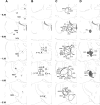
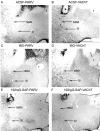
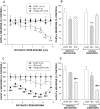

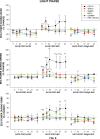



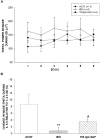
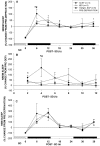

Similar articles
-
Histamine release in the basal forebrain mediates cortical activation through cholinergic neurons.J Neurosci. 2012 Sep 19;32(38):13244-54. doi: 10.1523/JNEUROSCI.5933-11.2012. J Neurosci. 2012. PMID: 22993440 Free PMC article.
-
The role of cholinergic basal forebrain neurons in adenosine-mediated homeostatic control of sleep: lessons from 192 IgG-saporin lesions.Neuroscience. 2008 Nov 11;157(1):238-53. doi: 10.1016/j.neuroscience.2008.08.040. Epub 2008 Aug 27. Neuroscience. 2008. PMID: 18805464 Free PMC article.
-
Immunolesion by 192IgG-saporin of rat basal forebrain cholinergic system: a useful tool to produce cortical cholinergic dysfunction.Prog Brain Res. 1996;109:253-64. doi: 10.1016/s0079-6123(08)62109-3. Prog Brain Res. 1996. PMID: 9009714 Review.
-
Differential changes of nicotinic receptors in the rat brain following ibotenic acid and 192-IgG saporin lesions of the nucleus basalis magnocellularis.Int J Dev Neurosci. 1998 Nov-Dec;16(7-8):661-8. doi: 10.1016/s0736-5748(98)00076-8. Int J Dev Neurosci. 1998. PMID: 10198814
-
[Neurochemical mechanisms of sleep regulation].Glas Srp Akad Nauka Med. 2009;(50):97-109. Glas Srp Akad Nauka Med. 2009. PMID: 20666118 Review. Serbian.
Cited by
-
Arousal and sleep circuits.Neuropsychopharmacology. 2020 Jan;45(1):6-20. doi: 10.1038/s41386-019-0444-2. Epub 2019 Jun 19. Neuropsychopharmacology. 2020. PMID: 31216564 Free PMC article. Review.
-
Basal Forebrain Cholinergic Neurons Primarily Contribute to Inhibition of Electroencephalogram Delta Activity, Rather Than Inducing Behavioral Wakefulness in Mice.Neuropsychopharmacology. 2016 Jul;41(8):2133-46. doi: 10.1038/npp.2016.13. Epub 2016 Jan 22. Neuropsychopharmacology. 2016. PMID: 26797244 Free PMC article.
-
Histamine release in the basal forebrain mediates cortical activation through cholinergic neurons.J Neurosci. 2012 Sep 19;32(38):13244-54. doi: 10.1523/JNEUROSCI.5933-11.2012. J Neurosci. 2012. PMID: 22993440 Free PMC article.
-
Fiber pathway pathology, synapse loss and decline of cortical function in schizophrenia.PLoS One. 2013 Apr 8;8(4):e60518. doi: 10.1371/journal.pone.0060518. Print 2013. PLoS One. 2013. PMID: 23593232 Free PMC article.
-
Cholinergic neurons of the basal forebrain mediate biochemical and electrophysiological mechanisms underlying sleep homeostasis.Eur J Neurosci. 2015 Jan;41(2):182-95. doi: 10.1111/ejn.12766. Epub 2014 Nov 4. Eur J Neurosci. 2015. PMID: 25369989 Free PMC article.
References
-
- Arrigoni E, Chamberlin NL, Saper CB, McCarley RW. Adenosine inhibits basal forebrain cholinergic and noncholinergic neurons in vitro. Neuroscience. 2006;140:403–413. - PubMed
-
- Basheer R, Strecker RE, Thakkar MM, McCarley RW. Adenosine and sleep-wake regulation. Prog Neurobiol. 2004;73:379–396. - PubMed
-
- Bassant MH, Apartis E, Jazat-Poindessous FR, Wiley RG, Lamour YA. Selective immunolesion of the basal forebrain cholinergic neurons: effects on hippocampal activity during sleep and wakefulness in the rat. Neurodegeneration. 1995;4:61–70. - PubMed
-
- Berntson GG, Shafi R, Sarter M. Specific contributions of the basal forebrain corticopetal cholinergic system to electroencephalographic activity and sleep/waking behaviour. Eur J Neurosci. 2002;16:2453–2461. - PubMed
Publication types
MeSH terms
Substances
LinkOut - more resources
Full Text Sources
Miscellaneous
